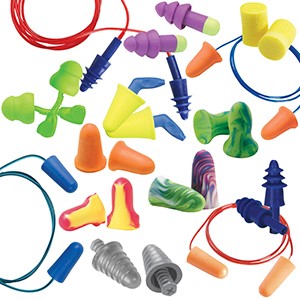Ear Plugs – What You Need to Know

Why use ear plugs
The Occupational Safety and Health Administration (OSHA) states that 22 million workers are exposed to noise at work that could damage their hearing, with $1.5 million in penalties and $242 million spent yearly on workers’ comp for hearing loss disability.
Even short term exposure to loud noise can cause a change in hearing with the feeling that ears are stuffed up or ringing in the ears. It could take minutes or hours for these effects to go away and continued exposures can lead to permanent damage.
Physical and psychological stress, reduced productivity, hearing high pitched sounds, and communication and concentration issues are only a few problems associated with hearing loss. Difficulty hearing warning signals also contribute to workplace accidents and injuries.
When to use ear plugs
Noise-level testing determines the noise levels generated by equipment in the workplace and at jobsites. Sound meters measure noise levels and are easy-to-operate and lightweight. OSHA requires a hearing conservation program when worker noise exposure is equal to or greater than 85 dBA for an 8 hour exposure and in the construction industry when exposures exceed 90 dBA for an 8 hour exposure.
When administrative or engineering controls fail to reduce sound levels to acceptable levels as determined by OSHA standards, personal protective equipment shall be provided and used to reduce sound levels.
NRR To ensure the average noise level is safe for employees, measure it with sound level meters or badges. Some meters can provide a time weighted average (TWA), calculating average noise levels throughout a period of time, such as an 8-hour workday. Others measure sound only at a given moment, so several readings need to be taken to determine the TWA.
When workers will be using ear plugs, follow these steps to determine noise exposure reduction:
- Determine the Noise Reduction Rating (NRR) which is usually listed on the product’s packaging
- Measure the workplace noise level
- Subtract the NRR from the noise level
- The resulting number should be 85 dB or less
This formula assumes a C-weighted sound level meter is used. Sound level meters are equipped with C, A, or both C and A decibel frequency weighting scales. The C scale represents how the ear perceives noise at high decibels and an A scale most closely resembles the human ear.
Examples of noise levels include:
- Normal Concentration - 60dB
- Sanding - 85d
- Woodworking - 100d
- Power Saw - 110dB
- Auto Traffic - 75dB
- Subway - 90dB
- Drilling (pneumatic) - 100dB
- Gunfire - 120dB
Choosing ear plugs
When choosing ear plugs, consider: convenience, communication requirements, comfort, amount of noise reduction the hearing protection provides, hygiene, hearing ability, and noise levels in the work area.
A wide variety of ear plugs exist. Each type is designed to offer unique features and benefits. Common types of ear plugs include:
- Roll down foam ear plugs, or disposable ear plugs, offer good protection and fit many different ear canal shapes
- Reusable ear plugs can be metal detectable, are a convenient choice because they often feature flanges and handles for easy insertion, come in different sizes, and are washable
- Custom molded ear plugs provide customized hearing protection that is molded to the specific shape of the workers ear canal
Ear plugs can be uncorded or corded, and may be equipped with cords that are removable. Corded plugs help reduce loss and keep ear plugs close at hand.
Many styles of disposable ear plugs are available and offering a variety to workers helps with worker compliance and compliance checks. When providing disposable ear plugs, bright colors, cool names, and different shapes, from a cylinder to pod plugs with stems, will offer workers a variety. Purchasing 750 ear plugs in one style, compared to 750 plugs in 3 different styles often works out to being about the same cost and can offer better results against hearing damage, penalties, and workers comp costs.
Using ear plugs
The Center or Disease Control and Prevention (CDC) recommends following the steps below to get the best hearing protection possible with ear plugs:
- Grasp the ear plug firmly in your fingers. Using your thumb and fingers, roll the plug into a small, thin strand to make insertion easier.
- Pull the top of the ear back and up to straighten out the ear canal. This can be done with the hand opposite the ear, and should allow the ear plug to slide into place.
- Hold the ear plug in place and count out loud for 20 to 30 seconds. Counting aloud will allow you to hear when a good seal has been created, as your voice will become muffled.
- Ensure the ear plug is firmly inserted in the ear canal. If you find the plug is loose, restart the process.
Pod plugs offer a rigid stem and others a “T-handle” to help with insertion and removal.
Once the appropriate ear plugs are selected, train employees to understand the risks and how to properly use their ear plugs. Ensure workers wear protection by regularly monitoring compliance and posting hearing protection signs in areas with hazardous noise.





